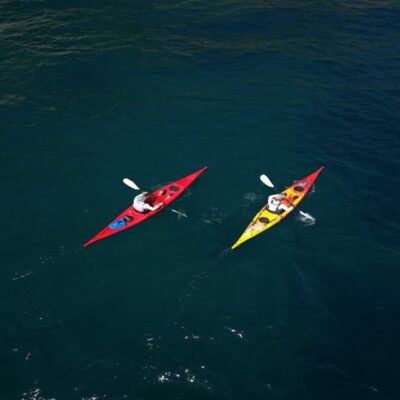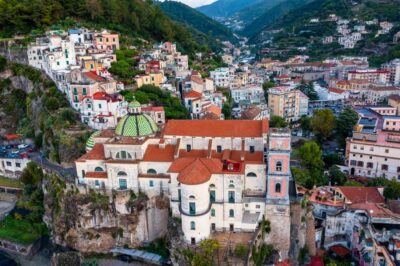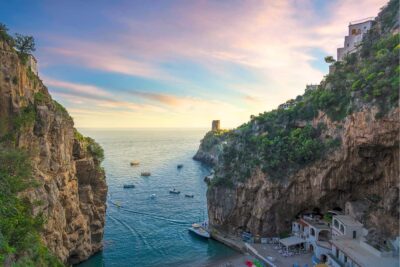Ravello Cathedral is a church dedicated to Santa Maria Assunta, whose construction dates back to the late 11th century.
It is a basilica of Benedictine-Cassinese derivation, with three naves divided by huge columns and a raised transept due to the presence of the underground crypt. The cathedral is part of the artistic beauties of Ravello and the Amalfi Coast that every year attract millions of tourists to these magnificent places full of history, art and culture.
Indice dei contenuti
History and characteristics of Ravello Cathedral
The cathedral was founded in 1086 based on the model of the Montecassino abbey, and construction was completed around 1087. The architraves of the three doors in the façade date from this period. The main bronze door was donated by a nobleman from Ravello, Sergio Muscettola, made by Barisano da Trani in 1179.
It consists of two wooden doors with 80 panels: 54 figured, 26 decorative. The decoration technique used for the panels is bas-relief. The iconographies depict, from bottom to top, the animal and plant world, the human and celestial universe.
Inside the Cathedral, two magnificent amboes can be admired in the nave. The Gospel pulpit was made by Nicola di Bartolomeo da Foggia in 1272. Opposite is the epistle pulpit, which depicts the biblical episode of the prophet Jonah and the sea monster. This second one was donated by the second bishop of the diocese Constantine Rogadeo in the 12th century.
The pulpit is a work by Nicola di Bartolomeo da Foggia, donated in 1272 by Nicola Rufolo. It consists of an access staircase and a chest and is adorned with portraits of Nicola Rufolo and his wife on the arch at the entrance to the inner staircase. In the centre of the pulpit is an eagle-shaped lectern holding a codex with the inscription: “in principio erat Verbum”.
Lastly, the chapel dedicated to the city’s patron saint, St Pantaleon, is remarkable. Built in the 17th century to provide a worthy location for the saint’s relics, it was kept until then beside the high altar.
In the centre of the chapel is a majestic painting of the martyrdom of the saint, a 1638 work by the Genoese painter Gerolamo Imperiali. The blood relic is kept in a gilded silver reliquary: every 27 July, the liquefaction of the Saint’s blood can be observed.
What characterises this cathedral is the presence of the Duomo Museums: the Opera Museum and the Medieval and Modern Art Gallery.
The Duomo Museums

The Museo dell’Opera del Duomo di Ravello was established in 1983 and is located in the crypt of the Basilica and in the part that was once the cathedral cemetery. You can visit the stone section, the painting section and the collection of the Icons of San Pantaleone, kept in the weekday chapel. You can also visit a Contemporary Art collection housed in the Tecta Street.
The crypt where the museum is located has a simple ground plan and corresponds to the entire space of the raised cross vault. It is crossed by a row of six granite columns that give shape to fourteen cross vaults, with different capitals, four Corinthian and composite, two medieval, one smooth and the other with starred rosettes, and the abacus faces bound by a smooth boron from which leaves hang. The columns at the entrance to the central apse have capitals decorated with lotus flowers.
The crypt was the seat of the Confraternity of Our Lady of Mount Carmel from 1679 to 1935, which was accessed via two staircases that were reopened during renovations in 1973. There were three altars in correspondence with the apses: the high altar was surmounted by an image depicting the coronation of the Blessed Virgin.
Of particular interest in the museum are some sculptural elements from the medieval bestiary that made up the 1279 ciborium, that canopy structure above the altar in churches, the work of Matteo da Narni and donated to the cathedral by Matteo Rufolo. The ciborium stood on four columns with Corinthian capitals supporting architraves decorated with mosaics and symbols of the four Evangelists.
The eagle, symbol of the Evangelist John, remained on the lunette of the main portal of the cathedral until 1973. Also of special interest is the bust of Sigilgaita Rufolo, formerly located on the entrance portal to the gospel ambo. Worthy of mention, finally, is the Falconer, a 13th-century work linked to the antiquarian taste of Frederick II.
The Art Gallery is accessed from the left aisle of the Cathedral. Here you will find a picture gallery from the 16th to the 19th century with paintings from the Cathedral chapels that are no longer there or from other nearby churches. Among the works are some by Giovanni Angelo and Giovanni Antonio D’Amato. The Pinacoteca leads to Via Tecta, where the contemporary art collection is kept.
If you know you’ll be staying in Ravello and want more information on monuments and attractions to visit, read our article dedicated to Villa Rufolo.
If you would like more information on how to get around the Amalfi Coast during your stay, we recommend downloading our free guide “Getting around the Amalfi Coast without stress“. Inside, we have collected all the useful and indispensable information you need to make your move from town to town easier.









